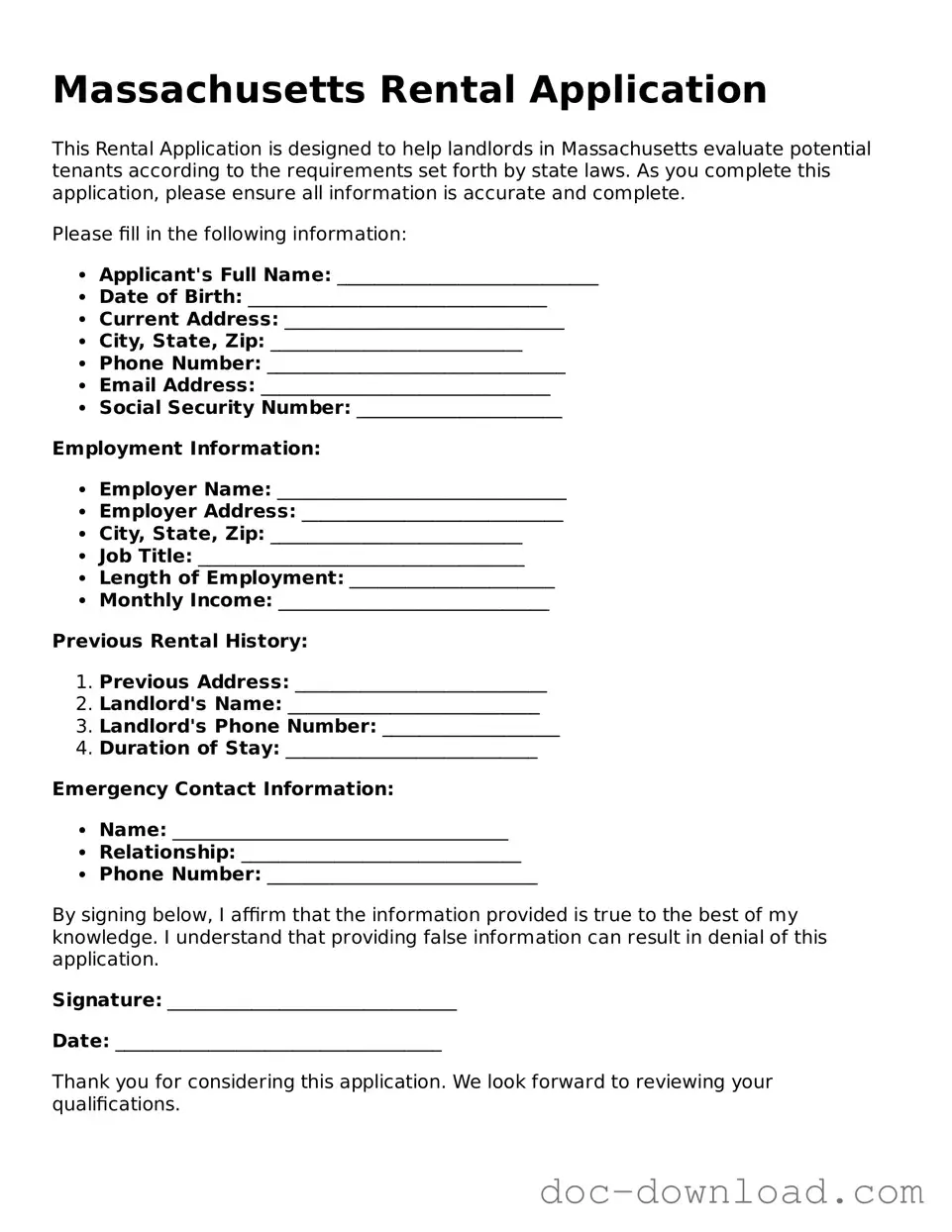The Massachusetts Rental Application form shares similarities with the standard Lease Agreement. Both documents serve to outline the terms of a rental arrangement. The Lease Agreement details the rights and responsibilities of both the landlord and tenant, establishing the duration of the tenancy, rent amount, and other essential conditions. The rental application, however, focuses on gathering information about potential tenants, which helps landlords make informed decisions before entering into a lease.
Another document akin to the Massachusetts Rental Application is the Tenant Background Check Authorization. This form allows landlords to obtain a tenant’s background information, including credit history and criminal records. Like the rental application, it aims to assess the suitability of a prospective tenant. The key difference lies in the focus; the background check authorization specifically seeks to verify the information provided in the rental application.
For those looking to understand the nuances of property transfer, a quitclaimdeedtemplate.com/florida-quitclaim-deed-template/ can provide essential information, as it outlines various methods for transferring ownership without the complexities of traditional ownership guarantees. This can be especially useful for simplifying transactions between parties.
The Rental Agreement Addendum is also similar to the Massachusetts Rental Application. This document supplements the main lease agreement by adding specific terms or conditions. While the rental application collects preliminary information about the tenant, the addendum may address particular issues such as pet policies or maintenance responsibilities that were not covered in the initial lease.
The Move-In Checklist is another related document. This form is often used to document the condition of the rental unit before a tenant moves in. While the rental application is focused on tenant qualifications, the move-in checklist ensures that both parties agree on the state of the property, helping to prevent disputes over security deposits at the end of the tenancy.
Similar to the rental application is the Rental Payment Agreement. This document outlines the payment terms for rent, including due dates and accepted payment methods. While the rental application collects tenant information, the rental payment agreement formalizes the financial obligations that will be established once the tenant is approved and a lease is signed.
The Guarantor Agreement also shares characteristics with the Massachusetts Rental Application. This document is used when a tenant requires a guarantor to co-sign the lease, often due to insufficient credit history or income. Like the rental application, it collects information about the guarantor, ensuring that the landlord has a reliable backup should the tenant default on payments.
The Security Deposit Receipt is another document related to the rental process. This form acknowledges the receipt of the security deposit from the tenant. While the rental application is focused on tenant screening, the security deposit receipt serves as a record of the financial transaction, protecting both the tenant and landlord in the event of disputes regarding the deposit at the end of the lease.
The Rental Property Disclosure Statement is also similar. This document requires landlords to disclose certain information about the property, such as lead paint hazards or the presence of mold. While the rental application assesses tenant qualifications, the disclosure statement ensures that tenants are informed about potential issues with the property before signing a lease.
Lastly, the Tenant Rights and Responsibilities Handbook is relevant to the rental application process. This document outlines the rights and obligations of tenants under Massachusetts law. While the rental application focuses on tenant information and screening, the handbook serves as an educational tool, helping prospective tenants understand their rights before entering into a rental agreement.
